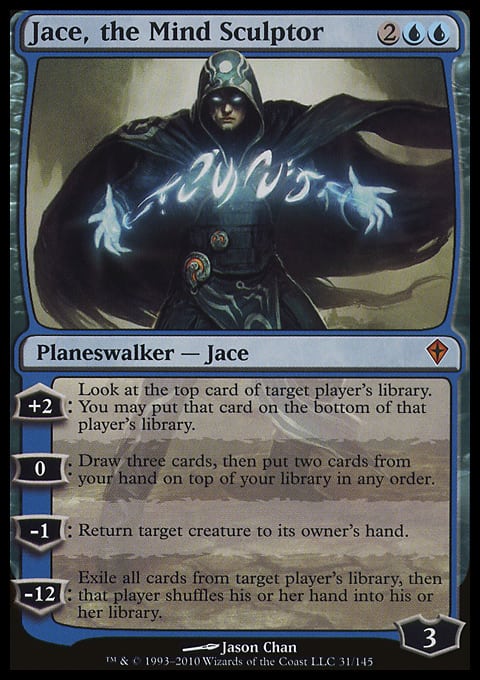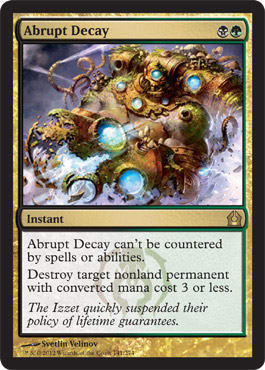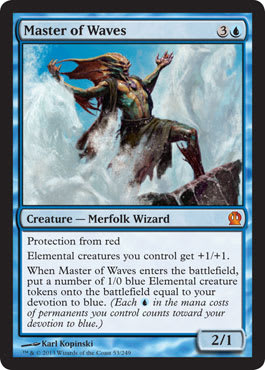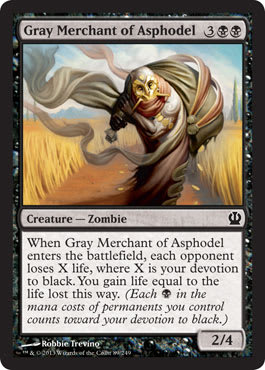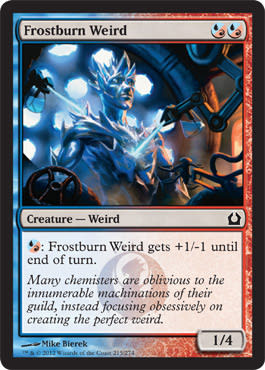I’m going to do something crazy, you guys.
I’m going to actually play in a Grand Prix.
True story. I’ve been doing coverage for so long that I’ve almost forgotten what that feels like. When a Grand Prix comes to the state of Texas, I usually use it as a way to get a coverage gig in without having to fly anywhere. I even declined to play the last time we had Grand Prix Austin (where I live).
But not this time. For this next iteration of Grand Prix Dallas, I’m going to sleeve up my deck (more on that later) and actually sling some spells. Due to my extended period without a major tournament, I’m going to be battling without any byes, but we’ll just view that as more practice before Round 4. At least that’s what I’m telling myself.
At any rate, something about this Grand Prix feels familiar. The last time we had a Grand Prix Dallas, I was on the coverage team and noticed something odd about the Top 8 as it coalesced. The eight archetypes were split neatly between two decks: four Caw-Blade and four R/U/G decks, both with Jace, the Mind Sculptors aplenty.
Fast-forward what seems like a million years, and Grand Prix Albuquerque sets the stage for a similar scenario. The Top 8 was very nearly split between two decks—mono-black and mono-blue devotion—with a single interloper spoiling a million “black and blue” puns. We even have a ubiquitous blue-card split between the top decks, as Nightveil Specter looms large-ish over the format.
So, is this Dallas all over again? Are we headed for a two-deck format? Or are we already there?
Let’s look at the evidence.
The Best Players Played One or the Other . . . or an Inferior Deck
Let’s start with the first half of that proposition. Of the ranked players who played in Albuquerque, almost all of them played one of three decks: mono-blue, mono-black, or Kibler B/G.
Owen Turtenwald (currently Number 16 in the Magic Top 25 Pro Rankings), Paul Rietzl (20), Tom Martell (10), and Eric Froehlich (13) all played mono-black and finished, respectively, 1st, 8th, 14th, and 28th. Throw in Matt Sperling’s virtual Top 8 (he not only played the same list, but offered a draw to friend Paul Rietzl when playing for the Top 8 with the win on the board; he was jumped in tiebreakers to miss out) and Todd Anderson’s third-place finish, and mono-black was not only very successful, but was also put in the hands of some of the most talented players on the planet.
Mono-blue’s devotees were fewer among the ranked, but Sam Black (8) is on one of the hottest streaks of any player’s life right now (four straight major event Top 8s—1 Pro Tour and 3 Grands Prix), and much of that success has come with mono-blue devotion at his fingertips. Additionally, finalist Sam Pardee has another Grand Prix title under his belt and is certainly no slouch, while Grand Prix Detroit winner and Grand Prix Miami Finalist Josh McClain quietly finished in the Top 16 with mono-blue devotion as well.
After that, the rest of the ranked players playing in the tournament tell an interesting story. Much of the ChannelFireball team was playing an aggressive B/G deck straight out of Brian Kibler’s (17) brain. Josh Utter-Leyton (2) was the only one to finish in the Top 64. Kibler himself finished 114th.
Now, I call the B/G deck an “inferior deck” without having played a game with it. It didn’t look terribly impressive on camera, but I have no actual experience with the deck. Still, the deck didn’t perform particularly well on Day 2. Abrupt Decay is a very real card in the format and might just be the best removal spell available, and Golgari Charm is excellent as well, so I wouldn’t sleep on a Golgari deck being good, but this wasn’t a great debut and won’t inspire many people to pick it up.
So, if the best players were, by and large, on one of these decks, and these decks performed well, what can we glean from that?
Oddly enough, it’s not much. I think we can safely assume that the B/G deck isn’t ready for prime time yet, but Sam Black seems to be able to Top 8 at will since the Pro Tour, and Owen is an oath brother, so I imagine he’ll keep winning GPs until either Reid Duke or Huey Jensen quits Magic, breaks the oath, or dies of old age, none of which is happening any time soon. So, do we assume they did so well because they’re just that good (likely) or do we look at their archetypes’ performances and conclude that they picked the best decks and played well (also likely)?
In other words, did the best players pick the best decks, or did the best players make the best decks the best because they were so expertly piloted? It’s probably a bit of both, so we’ll call this one a wash.
Mono-Black and Mono-Blue Became Better as the Tournament Went On . . . but Still Weren’t the Whole Story
We don’t have a ton of evidence for this, but it seems to be the case. The Day 1 top tables breakdown show small but significant slices of black and blue devotion decks. On Day 2, out of the entire field, black devotion was actually the third-most-popular deck, behind blue and Esper control, but none of them comprised more than sixteen percent of the entire field. That’s far from dominating, but those two charts, coupled with a far more diverse Top 16 just outside the Top 8, seems to indicate that both mono-black and mono-blue became better as the tournament went on—but hardly trumped the entire field.
However, it’s hard to call something a two-deck format when fully seventy percent of Day 2 was playing something else. If you compare to Grand Prix Dallas in the era of Caw-Blade and R/U/G, you’ll notice that the metagame then was far more top-heavy.
So, what does this all mean? It seems to indicate that blue and black devotion decks are very good (you already knew that), but are far, far from the only choices going in.
Other Decks Are Caught between a (Brittle) Rock and a Hard-ish Place
When black devotion rose to prominence after the Pro Tour, players eventually discovered they could beat it with fast red decks. Black devotion is either a midrange or control deck, depending on whom you ask, and it struggles with decks with low curves and reach.
The problem is that mono-blue excels against exactly that kind of strategy. Tidebinder Mage, Frostburn Weird, and Master of Waves make life incredibly difficult for exactly the kind of deck to exist.
Now let’s look at the other end of the spectrum with Esper. Esper has a generally favorable matchup against blue devotion and a generally unfavorable matchup against black devotion (though Game 1 is more in Esper’s favor than people seem to recognize). So, you could pick Esper, but you’re simply flipping which matchup is favorable. And even then, the matchups aren’t so favorable that you’re able to waltz right past them.
Other attempts to find a space between the decks have flared up and fallen by the wayside. Naya, the only other deck to Top 8 Albuquerque, has occasionally demonstrated its flexibility, but the mana isn’t great (Andrew Hanson had exactly four nonbasic lands in his deck), and the exact build is questionable. Do you go with Andrew Hanson’s beatdown style or Brad Nelson’s control version with Assemble the Legion?
But Standard isn’t about absolute matchups. “Good” matchups are much less good these days, while “bad” matchups are much less bad. This might be an indication of why we see so many top pros doing well at these tournaments—there’s less of an edge to be gained purely on deck choice.
So, a deck caught between these two decks isn’t necessarily just out of luck. That, in turn, leads to a ton of diversity and give players reasons to play decks on one end of the spectrum or the other.
Want to play mono-red? You can, and you’ll expect to beat black a fair percentage of the time while still having plenty of game against blue. Want to play Esper? You can, and you’ll expect to beat blue a fair percentage of the time while still having some game against black.
It Was Just One Tournament
It wasn’t even a particularly big Grand Prix, coming in at under a thousand players. For a U.S., Standard Grand Prix, that’s positively tiny. Albuquerque isn’t the easiest place to make it to from other major population centers, but then again, neither is Dallas.
That same weekend, there was a StarCityGames Open in which not a single black deck made the Top 8, and only two made Top 16. Blue put four copies in the Top 8, but none in the finals and only one more in the Top 16.
And if you go back to Grand Prix Santiago, you see a bevy of blue devotion, but little black (and zero Sam Black).
So, no, Albuquerque doesn’t mean we have another Dallas on our hands. Dallas was part of a bigger trend wherein Jace decks took over the format. Nightveil Specter may be good, but it certainly isn’t Jace good.
Conclusion
No, it’s not a two-deck format. A lot of people are going to overreact to Albuquerque and either play blue and black in droves or play decks they think (probably incorrectly) can beat them.
Thankfully, Grand Prix Vienna this weekend is also Standard, giving the format another opportunity to overreact one way or another.
I say “thankfully” because, at this point, I’m almost certainly playing mono-blue. Since the release of Theros, I’ve played Blue, Esper, and Junk exclusively, and while I like all three decks, blue seems to be the best choice for me. For one, I have zero byes, and the idea of playing Esper for up to nine rounds sounds exhausting. I play the deck very fast, but even then, any three-game set is going to take you close to time. Junk, meanwhile, is fun and actually very good, but it isn’t nearly tuned enough to bank on.
That leaves blue devotion. With no byes, I want something strong and—above all—consistent. Esper, as much power as it has, isn’t consistent. The mana base can bite you more often than I’d like, removal can be spotty depending on the threat, and the sheer variety of things you need to answer leaves me wanting a twenty-card sideboard. Plus, the deck is vulnerable to fast red decks, which I think will be somewhat popular, especially in the early rounds.
That could all change between now and Dallas, but Albuquerque only reinforced my view of the format and underscored my own strengths in Standard. Vienna is yet another opportunity for everything to turn on its head, but given recent results, I don’t expect that to happen.













